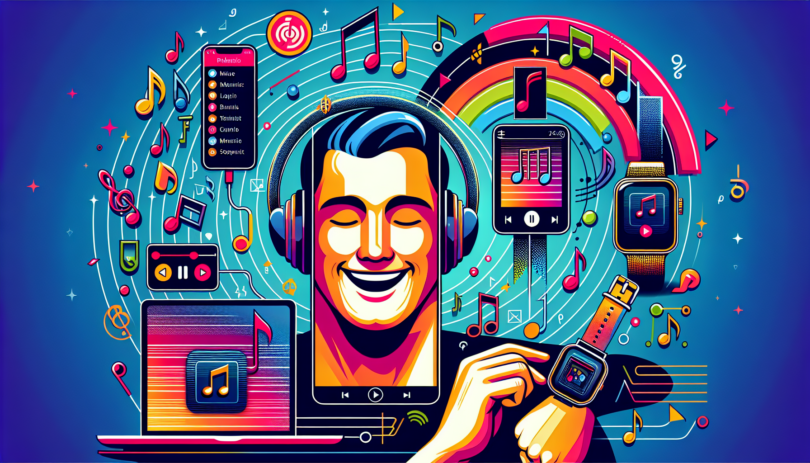Understanding the Importance of Syncing Apple Music
In today’s digital age, music is more than just a pastime; it’s an integral part of our daily lives. Ensuring your favorite tunes are available anytime and anywhere can significantly enhance your listening experience. Syncing Apple Music across all your devices not only offers unparalleled convenience but also ensures that your music library remains unified and accessible, no matter which device you’re using. Whether you’re switching from your iPhone to your iPad or working on your Mac, having your entire music collection at your fingertips allows for a seamless and enjoyable musical journey.
A unified music library across all platforms means you can enjoy greater flexibility in how you interact with your music. No longer will you need to manually transfer songs or worry about missing out on new tracks added to one device but not the others. Syncing Apple Music makes it easier to manage your playlists, download songs for offline listening, and take full advantage of Apple Music’s features, ultimately elevating your overall music experience.
Understanding the Importance of Syncing Apple Music
Enhancing Your Listening Experience
In today’s digital age, music streaming has become an integral part of our daily lives. One of the key players in the music streaming industry is Apple Music, which offers an extensive library of songs to suit every taste. However, to fully harness the power of Apple Music, it’s essential to sync Apple Music across all your devices. Syncing your music ensures a seamless and enriched listening experience, no matter which device you use. Whether you’re at home on your Mac, commuting with your iPhone, or relaxing with your iPad, your favorite tunes will always be at your fingertips.
Unified Music Library: The Ultimate Flexibility
The most significant benefit of syncing Apple Music across multiple devices is the creation of a unified music library. When your music library is synced, any changes made on one device—such as adding a new album, creating a playlist, or downloading songs—are automatically reflected across all your devices. This means you no longer have to manually transfer files or worry about inconsistencies between devices. Simply make your changes once, and enjoy the benefits everywhere.
Effortless Accessibility
Another advantage of syncing Apple Music is the effortless accessibility it provides. With a synced library, you can easily pick up where you left off on any device. Did you start listening to a playlist on your iMac during a work session? No problem. You can continue listening on your iPhone while taking a walk or on your iPad while relaxing on the couch. This flexibility ensures that your musical experience is smooth and uninterrupted, regardless of the device you are using.
Personalized Experience
Syncing Apple Music also enhances your personalized listening experience. Apple Music’s algorithms adapt to your listening habits and preferences to provide recommendations tailored just for you. When your library is synced, these recommendations become even more accurate, as they are based on your listening history across all devices. This unified approach ensures that you receive the best possible music suggestions, personalized to your tastes.
Space-Saving Benefits
One often-overlooked benefit of syncing Apple Music is the space-saving potential. Rather than storing music files locally on each device, syncing allows you to leverage the power of the cloud. Your entire music library is stored in iCloud, which means you can access your music without taking up valuable storage space on your devices. This is especially useful for those with devices that have limited storage capacity.
Consistency and Organization
A synced Apple Music library maintains a consistent and organized collection of your favorite tunes. Playlists, albums, and individual tracks are uniformly arranged across all devices. This consistency eliminates the hassle of searching for specific songs or re-organizing your library multiple times. Your music remains neatly categorized and easy to navigate, whether you’re using your iPhone, iPad, or Mac.
Peace of Mind
Lastly, syncing Apple Music across your devices offers peace of mind. With iCloud backups, you don’t have to worry about losing your music collection due to device failure or loss. Your music is safely stored in the cloud, and can be easily restored to a new device. This security feature ensures that your carefully curated music collection is protected and always available, no matter what happens to your individual devices.
Conclusion
In summary, syncing Apple Music across all your devices is not just a convenient feature—it’s a game changer. It enhances your listening experience, provides unparalleled flexibility, saves storage space, maintains consistency, and offers peace of mind. As we continue to integrate digital solutions into our daily lives, having a unified and accessible music library becomes essential. Sync Apple Music across your devices today, and enjoy a seamless and enriched musical journey.
Step-by-Step Guide to Sync Apple Music Across iPhone, iPad, and Mac
Detailed Instructions on Enabling iCloud Music Library on Various Apple Devices
Syncing Apple Music across your iPhone, iPad, and Mac ensures that your music library is always up-to-date regardless of which device you’re using. The iCloud Music Library feature allows you to store your entire music collection in the cloud, making it accessible anywhere. Below is a comprehensive guide on how to enable iCloud Music Library across all your Apple devices.
Enabling iCloud Music Library on iPhone
- Open the Settings app.
- Scroll down and tap on Music.
- Toggle on the switch next to Sync Library (or iCloud Music Library for older iOS versions).
- If prompted, confirm that you want to enable iCloud Music Library.
By following these steps, you ensure that your music collection is synced to your iPhone. You will now see all your playlists, albums, and tracks reflected instantly.
Enabling iCloud Music Library on iPad
- Open the Settings app.
- Navigate to Music.
- Enable the Sync Library option by toggling the switch.
- Accept any confirmations that appear, indicating that you wish to use iCloud Music Library.
Your iPad will now have access to the same music library as your other Apple devices, ensuring seamless switching between devices without losing your place in your favorite songs or playlists.
Enabling iCloud Music Library on Mac
- Open the Music app on your Mac.
- In the top-left corner, click on Music in the menu bar, then select Preferences.
- Go to the General tab.
- Check the box next to Sync Library (previously known as iCloud Music Library).
- Click OK to save your settings.
Your Mac is now set up to sync music with iCloud, ensuring you have a unified library across all your Apple devices. This simple setup eliminates the hassle of managing multiple music libraries.
Troubleshooting Common Issues Faced While Syncing Apple Music
Connectivity Issues
One common issue when trying to sync Apple Music is poor internet connectivity. Ensure that all your devices are connected to a stable Wi-Fi network. If you’re experiencing connectivity issues, try restarting your router or switching to another network.
iCloud Storage Concerns
Another frequent problem is insufficient iCloud storage. Since your music library is stored in the cloud, you need to ensure you have enough iCloud storage available. Consider upgrading your iCloud storage plan if necessary:
- Open Settings.
- Tap on Your Name at the top, then select iCloud.
- Review your iCloud storage and upgrade if needed by tapping Manage Storage and selecting a new plan.
Ensure All Devices Use the Same Apple ID
Syncing issues can also arise if the devices are logged into different Apple IDs. Verify that all your devices are logged into the same Apple ID:
- Open Settings on your iPhone or iPad, or System Preferences on your Mac.
- Tap or click on Your Name and ensure the Apple ID listed matches across all devices.
Software Updates
Outdated software can also lead to syncing issues. Ensure that all your devices are running the latest versions of iOS, iPadOS, or macOS:
- Open Settings on your iPhone or iPad, then go to General and tap Software Update.
- On Mac, open System Preferences and select Software Update.
Final Thoughts
By following these detailed instructions and troubleshooting tips, you can ensure that you successfully sync Apple Music across your iPhone, iPad, and Mac. Enjoy the convenience of a unified music library, enhancing your listening experience no matter where you are.
Maximizing Your Apple Music Experience Post Sync
Efficiently Managing Your Synced Music Library
Once you’ve successfully synced Apple Music across all your devices, it’s crucial to learn how to manage your music library effectively to make the most of your experience. An organized library not only saves time but also enhances the joy of discovering new music and revisiting your favorites.
First, take advantage of the custom playlist feature. Creating custom playlists allows you to organize music based on various moods, genres, or events. Whether you’re setting up a workout mix or a playlist for your next road trip, having these ready at your fingertips can make a huge difference. You can create and edit playlists directly from your iPhone, iPad, or Mac, and any changes will sync automatically to all your devices.
Another helpful tip is to regularly update your library. As you discover new music or your tastes evolve, ensure that you delete songs or albums that you no longer listen to. Not only does this keep your library fresh, but it also optimizes your device’s storage. Use the Recently Added section to quickly access new additions and decide whether they merit a permanent spot in your library.
Don’t forget to rate your songs. Apple Music’s five-star rating system can help you filter your favorite tracks easily. You can sort your library by rating, making it simpler to find your top-rated songs when you’re in the mood for the best of the best.
Leveraging the search and filter options within Apple Music can also significantly improve your experience. Use filters to view music by artist, album, or genre, and utilize the search function to quickly locate specific tracks. These tools can save you time and reduce frustration when navigating through an extensive collection of music.
Exploring Additional Features Like Offline Listening
One of the standout features of Apple Music is the ability to download music for offline listening. This is particularly useful if you are in areas with poor internet connectivity or trying to conserve your mobile data. Here’s how to make the most of this feature:
To download music, simply tap the cloud icon next to any song, album, or playlist. The music will be available for offline listening and can be accessed through the Library tab. Remember to frequently update these downloads, especially if you’re rotating between favorite playlists or newly discovered tracks. Offline music can be managed through the Downloaded Music section, where you can easily add or remove downloads as needed.
To ensure you have uninterrupted access to your favorite songs, consider enabling the Automatic Downloads feature. This ensures that any song you add to your library is automatically downloaded to your device. Go to Settings > Music > Automatic Downloads on your iPhone or iPad to turn this feature on.
Sharing Playlists with Friends and Family
Music is often a shared experience, and Apple Music’s playlist sharing feature makes it easy to share your musical tastes with friends and family. Whether you’re creating a collaborative playlist for a party or sharing your favorite new tracks, playlist sharing can enhance your music experience.
To share a playlist, go to the playlist in your library, tap the more options button (the three dots), and select Share Playlist. You can send the playlist via Messages, Mail, or any other sharing app on your device. Moreover, your friends can add music to collaborative playlists, making it a joint effort to create the ultimate mix.
For those iOS users, make use of the Family Sharing feature. With an Apple Music family subscription, up to six family members can share access to Apple Music. Each person will have their own library, preferences, and recommendations, ensuring that everyone’s tastes are respected.
Exploring Curated Playlists and Radio
Apple Music is known for its expertly curated playlists and radio shows that cater to a wide variety of tastes and genres. After syncing your music, take some time to explore these features:
Curated playlists like “Today’s Hits” or “Chill Mix” are updated regularly, so you always have fresh music to discover. Apple Music’s editorial team crafts these playlists to highlight new releases, trending tracks, and hidden gems. You can follow these playlists and save your favorite ones to your library for easy access.
The Apple Music Radio service offers live radio shows hosted by renowned DJs and artists. Shows like “Beats 1” feature exclusive interviews and first listens of upcoming tracks. Listening to these radio shows can keep you at the forefront of the music scene and introduce you to genres or artists you might not have discovered on your own.
Conclusion
Syncing Apple Music across all your devices opens up a world of opportunities to elevate your listening experience. By efficiently managing your library, taking advantage of offline listening, sharing playlists, and exploring curated content, you get the most out of your Apple Music subscription. With these tips, you’ll find that your synced Apple Music library becomes a personalized, ever-evolving hub of your favorite sounds.
Conclusion: Harmonizing Your Apple Music Experience
Syncing Apple Music across all your devices not only enhances your listening experience but also provides unparalleled flexibility in enjoying your favorite tunes anytime and anywhere. By following the detailed step-by-step guide, you can effortlessly enable iCloud Music Library and ensure your playlists, albums, and favorite tracks are unified across your iPhone, iPad, and Mac.
Seamless Music Management
Once your devices are synchronized, managing your music library becomes a breeze. You can create shared playlists, enjoy offline listening, and explore new tracks without the worry of losing your curated music collection. Additionally, the convenience of having access to your entire library on any device cannot be overstated.
Unlocking the Full Potential of Apple Music
Beyond syncing, Apple Music offers a robust set of features that can elevate your music experience. Curate mood-based playlists, discover new genres, or collaborate on playlists with friends. The more you explore, the more ways you’ll find to enjoy your music seamlessly across all your devices.
In conclusion, syncing Apple Music across your Apple ecosystem ensures a harmonious and enriched listening experience. Embrace the full scope of what Apple Music has to offer and let the rhythm follow you no matter where you go.








